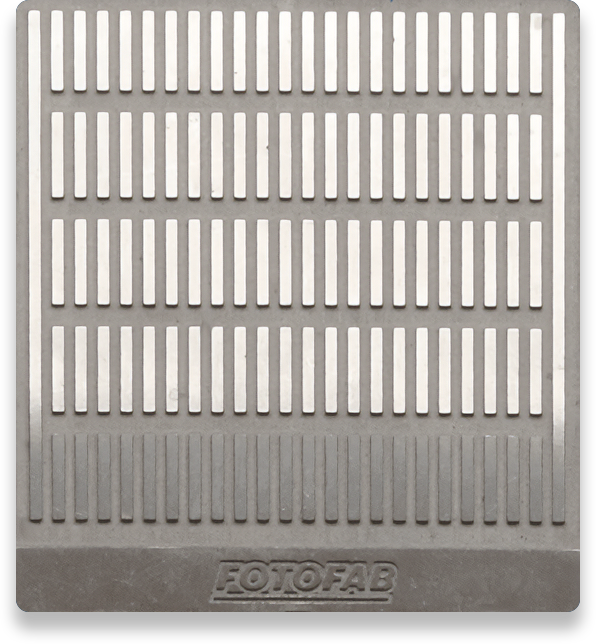Photochemically Etched Bipolar Plates
Leaders in precision thin metal etched parts, Fotofab offers superior quality and precision for the production of bipolar plates. Precision-etched bipolar plates are critical components in fuel cells, electrolyzers and flow batteries and electrochemical reactors, serving as the conductive medium that distributes reactant gases and collects current.
Our state-of-the-art photochemical etching technology ensures high accuracy, minimal material waste, and cost-effectiveness, making it an ideal choice for producing these intricate components. For very high volume production needs, Fotofab offers blanking as well as added value services such as plating, fusion bonding and coating.
- Improve electrical conductivity and reduce resistance
- Ensure optimal performance and efficiency through precise, complex flow field patterns
- Eliminate the need for expensive tooling and reduce material wastage
- Ensure consistent and repeatable production
- Produce complex shapes and tight tolerances
- Provide unparallelled design flexibility for prototyping, eliminating the need to wait for new tools when changing the design.
- Rapidly scale up to full production from prototyping.
- Maintain constant production cost regardless of design complexity.

Precision Bipolar Plate Components
Bipolar plates are critical components in fuel cells and electrolyzers that serve as conductive layers to distribute gases and conduct electrical currents between adjacent cells. They are typically made of conductive materials such as stainless steel, aluminum, nickel or titanium and feature intricate flow field patterns etched into their surfaces to manage the distribution of gases and cooling fluids.
Fotofab produces precise, custom made, high-quality bipolar plate components that includes design features such as:
Flow Fields:
Complex channels etched into the surface of the plates to ensure uniform distribution of gases.
Manifolds:
Precision cut openings for the inlet and outlet of gases and cooling fluids.
Current Collectors:
Conductive paths etched to optimize electrical conductivity.
Cooling Channels:
Intricate pathways designed to manage heat within the fuel cell system.
Surface Treatments:
Enhanced features such as ridges and patterns to improve overall performance and durability.
Our photochemical etching process adds no mechanical force or heat which means the plates are burr- and stress-free – with the internal intricacies needed for the overall fuel cell block without adding to the cost as production quantities increase. We offer a standard lead time of 3-4 business days on etching and delivery, depending on additional requested features. Fotofab offers blanking, fusion-bonding, plating, coating services, making us a one-stop-shop.
Typical Bipolar Plate Applications
Bipolar plates are typically used in fuel cells and electrolyzers and play a crucial role in the electrochemical processes that generate electricity or produce hydrogen. They are also used in redox flow batteries and other advanced energy storage systems, contributing to the efficient management and distribution of gases, liquids, and electrical currents.
Typical applications include:
Fuel Cells:
Used in hydrogen fuel cells for automotive, stationary, and portable power applications, providing efficient energy conversion.
Electrolyzers:
Employed in the production of hydrogen from water, essential for green energy solutions.
Batteries:
Advanced applications in flow batteries for energy storage systems.
Sensors:
Utilized in high-performance sensors requiring precise and reliable conductive components.
Metals Commonly Used in Photochemical Etching For Bipolar Plates
Fotofab employs a variety of metals in the photochemical etching process to ensure precision, durability, and accuracy.
Typical metals used for bipolar plates include:
Other alloys are available for specific project needs.
Fotofab Advantages
Leaders in photochemical etching, FotoFab offers advanced etching solutions for bipolar plate components, ensuring the highest precision and repeatability for complex designs.
Blending experience, expertise, and the latest in advanced technologies in our core products like stamping, plating, coating, fusion-bonding, we offer bespoke solutions tailored to specific customer requirements, enabling unique designs and rapid prototyping.
Adhering to strict quality control standards and certifications, we ensure each product meets or exceeds industry benchmarks for performance and reliability. Our proven process minimizes material waste and reduces production time, offering cost-effective solutions for high-volume manufacturing.
Benefits of Photochemically Etched Bipolar Plates
High-precision bipolar components designed and manufactured to perform.
Our state-of-the-art photochemical etching technology and proven etching process allow for the high-volume production of intricate and precise parts with high accuracy, minimal material waste and unparalleled design flexibility
With a focus on customization and collaboration, we deliver unique designs tailored to our client’s unique requirements and offer cost-effective solutions for high-volume manufacturing and rapid prototyping.
Benefits of this precision process include:
High Accuracy:
Achieve intricate and detailed digital designs that are not possible with traditional machining.
Flexibility:
Easily accommodate design changes and modifications without the need for expensive tooling.
Material Efficiency:
Save money by reducing waste and optimizing materials.
No Mechanical Stress:
Maintain material integrity by avoiding mechanical deformation during etching.
Scalability:
Efficiently scale from prototype to high-volume production.
Cost effective:
Eliminates the need for expensive and time-consuming tooling
Cost efficient:
Part complexity does not affect the production time
Rapid prototyping:
Produce different designs at the same time without added effort.
Fotofab is committed to quality.








